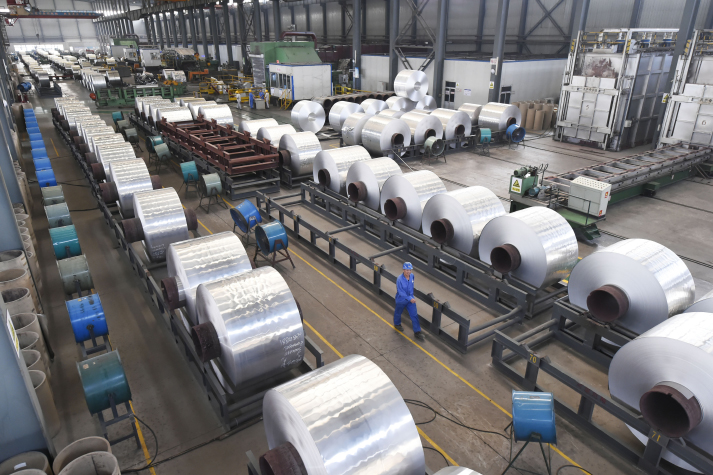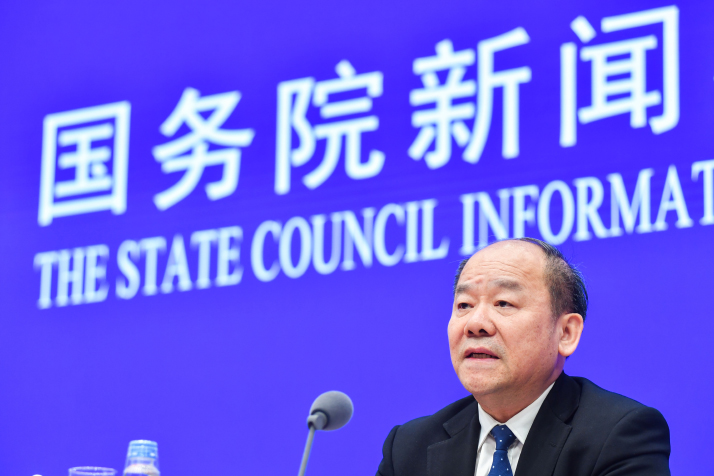| Editor's Choice |
| Tempered Strength | |
| Past year's performance gives Chinese economy buoyancy in 2019 | |
|
|
 An aluminum company's workshop in Zouping, east China's Shandong Province, on September 13, 2018 (XINHUA)
On January 21, when the travel rush for the traditional Chinese New Year holiday began, the National Bureau of Statistics (NBS) released the 2018 economic figures. The data have met the official growth target and shown the domestic economy's resilience despite volatility. China's economy grew 6.6 percent year on year in 2018, reaching the target of around 6.5 percent. The GDP totaled 90.03 trillion yuan ($13.32 trillion), crossing the 90-trillion-yuan milestone for the first time and increasing by nearly 8 trillion yuan ($1.17 trillion) over 2017. China remained the largest driving force of the world's economy, contributing over 30 percent of global economic growth, Ning Jizhe, chief of the NBS, said at the news conference where the figures were released. "The economy performed within a reasonable range in 2018, achieving stable growth and progress across the board," he said. However, the growth has slowed down. It was lower than the 6.8 percent in 2017. In the fourth quarter of 2018, the figure stood at 6.4 percent, down from 6.7 percent in the first three quarters. At a recent forum, Wan Zhe, chief economist with the China National Gold Group Corp., attributed the slowdown in 2018 partially to the domestic market sentiment influenced by the uncertainties caused by the Sino-U.S. trade friction and the Chinese Government tightening regulations to avert major risks. However, the GDP growth proved the resilience of the economy, following an L-shaped path where stable development follows slowdown. "Although China's economy will still confront great pressure this year, it will not stall but continue to register steady growth," Wan said. Stable performance The record high import and export volume, increasing 9.7 percent year on year, was a highlight of 2018. Trade with the European Union, the United States and the Association of Southeast Asian Nations grew 7.9 percent, 5.7 percent and 11.2 percent respectively. Trade with countries and regions involved in the Belt and Road Initiative contributed to the record, with the total value reaching 8.37 trillion yuan ($1.23 trillion), a 13.3-percent increase compared with 2017. Zhao Jinping, a researcher with the Development Research Center of the State Council, said since exports this year may face great downward pressure due to the gloomy global economy, more diverse markets should be explored and the domestic business environment improved. In his view, imports remain a potential driving force for domestic growth. "The past year saw a higher import growth rate than exports as consumers' demands expanded," he said. Consumption remained a major driving force of the economy in 2018, contributing 76.2 percent to GDP growth. With more disposable income and upgraded consumption concepts, Chinese are feeling empowered and buying more rationally. China also has the largest middle-income population, exceeding 400 million in 2017, which indicates greater consumption potential. Per-capita consumer spending reached 19,853 yuan ($2,925), a 6.2-percent increase year on year, 0.8 percentage point higher than the previous year's growth rate. Total retail sales of consumer goods, which indicate the pulse of an economy, also rose 9 percent year on year to 38.1 trillion yuan ($5.6 trillion). Wan said the domestic demand can be enhanced. "There is a prominent sign of consumption upgrading as people's demands are expanding, and many demands have not yet been fully satisfied," she said.  Ning Jizhe, head of the National Bureau of Statistics, speaks at a press conference in Beijing on January 21. During the conference, China's 2018 economic figures were released (XINHUA)
Higher quality
Chinese consumers' rising purchasing power and demands are forcing domestic manufacturing industries to upgrade and aim at the high ends of industrial chains, thereby contributing to the national economic restructuring. The service sector accounted for more than half of the GDP in 2018, which expanded 7.7 percent year on year. The value-added output of leading industrial enterprises climbed 6.2 percent year on year. Among them, hi-tech manufacturing, strategic emerging industries and equipment manufacturing rose by 11.7 percent, 8.9 percent and 8.1 percent respectively. "The growth rate of hi-tech manufacturing surpassed that of leading industrial enterprises by a large margin, which suggests steady progress in domestic economic restructuring," Zhao Xijun, Deputy Dean of the School of Finance at Renmin University of China, said at the forum. According to him, China's investment and financing system as well as the capital market need improvement to support the hi-tech and emerging industries. With the proposed launch of a science and technology innovation board on the Shanghai Stock Exchange, efforts have started to promote capital market reform for quality-oriented development. The real estate industry, which once played a vital role in boosting China's economic growth, has been regulated to avoid financial bubbles and ensure residents' housing needs are met. The past year saw the domestic housing market cool down with a crackdown on speculation. Housing sales by value rose 14.7 percent year on year, down from 14.8 percent in the first 11 months. According to Ni Pengfei, a researcher with the Chinese Academy of Social Sciences, China achieved its goal of reining in the housing market. The property control and changed expectations of market participants due to rising downward pressure jointly led to a decline in housing purchases. Although property investment rose 9.5 percent year on year in 2018, increasing by 2.5 percentage points over the previous year, this year may see a decline as investment in land purchasing may not be high, he added. "The government's stance on controlling the real estate market will remain unchanged despite minor adjustments in 2019," Ni said. Injecting impetus To cope with the economic growth slowdown and the challenging external environment, the government launched several fiscal and monetary policies in 2018, such as cutting taxes and fees for households and enterprises and announcing reserve requirement ratio (RRR) cuts. It also smoothed the monetary transmission mechanism and encouraged higher local government spending to dissolve the gray rhino risks—risks that are highly probable and would have high impact but yet are neglected. Investment also contributed to the impetus to the domestic economy. Private investment rose by 8.7 percent, increasing by 2.7 percentage points over the previous year's rate. However, according to Jia Kang, former Director of the Research Institute for Fiscal Sciences at the Ministry of Finance, while private investment improved, public investment needs to be further tapped. "It is clearly necessary to improve investment to expand domestic demands since there is still ample room for further growth," Jia said. Fixed-asset investment, which includes capital spent on infrastructure, property, machinery and other physical assets, increased 5.9 percent year on year though the growth rate dropped from the 7.2 percent in 2017. Ning said infrastructure investment showed weaker growth momentum compared to manufacturing industries. This remains a weak point that needs to be improved, he added. Though the global economic weakness has cast a shadow on cross-border investment, China remained an attractive destination for foreign investors. Zhao Jinping said China can expect considerable foreign investment this year too. "Transnational enterprises' investment has not waned, given the large domestic market with expanding demands," he said. The government launched four RRR cuts and focused on a prudent monetary policy to make financing more affordable and accessible for small, micro and private enterprises, which play a key role in China's economic growth. As these enterprises gained new growth momentum, domestic employment saw better prospects. More than 13 million new jobs were created in urban areas last year and the surveyed urban unemployment rate stood at 4.9 percent in late December, 0.1 percentage point lower than in November. In Wan's view, the increasingly open Chinese market also contributed to the resilient growth of the economy. The pre-establishment national treatment for foreign enterprises and the new nationwide negative list, which has reduced the number of out-of-bounds industries for foreign investors, have created a level playing field for all market players. However, Wan said that for a better business environment, cutting taxes and fees alone is not enough. Institutional costs need to be reduced to spur market vitality and commercialization of technological inventions.
What lies ahead In its 2019 Global Economic Prospects report released on January 8, the World Bank warned of "darkening skies" for the global economy and lowered China's projected growth in 2019 to 6.2 percent. Earlier, it had forecast 6.5-percent growth. This suggests China will face challenges this year to maintain steady economic performance while pursuing high-quality growth amid the global economic weakness. Zhao Jinping said the global economy may not continue the recovery it made in 2017 due to complications this year, which can make both emerging and developed economies suffer from the sluggish global market. For China, exports may be adversely influenced by falling investment and need to be boosted through improving the domestic business environment, exploring new markets and cutting taxes and fees. The trade tension with the U.S. has seen initial signs of easing as China and the U.S. push ahead with talks. According to Ning, trade cooperation between the two countries still shows great potential. In addition, domestic demands have been leading China's economic growth and can help ensure the resilience of the economy. Regarding concerns that the renminbi may depreciate due to the RRR cuts, Tan Yaling, Dean of the China Foreign Investment Research Institute, said the dollar will probably weaken this year, which would ease the depreciation pressure. The consumer price index and producer price index both presented moderate growth in late December 2018. Wan said a major reason was that though the prices of upstream products increased, the hike was not yet transmitted. "It suggests that China's economy may continue to grow at a slower pace, therefore still bearing downward pressure in the first half of 2019," she told Beijing Review. Still, she is upbeat about the performance this year. "With effective macroeconomic policies, the domestic economy can maintain its resilience and will not falter," she said. (All the data in this report are from the NBS, unless mentioned otherwise) Copyedited by Sudeshna Sarkar Comments to lixiaoyang@bjreview.com |
|
||||||||||||||||||||||||||||
|